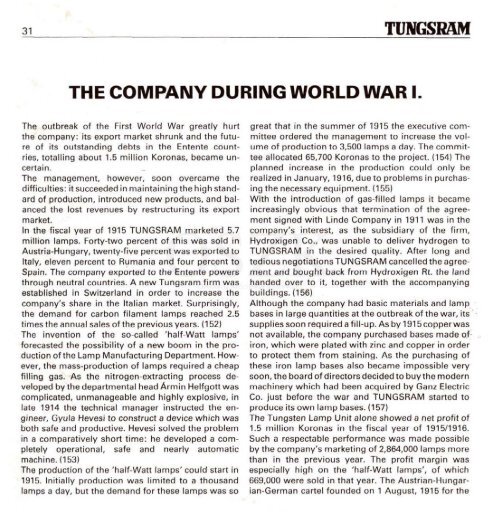THE HISTORY OF TUNGSRAM 1896-1945 - MEK
THE HISTORY OF TUNGSRAM 1896-1945 - MEK
THE HISTORY OF TUNGSRAM 1896-1945 - MEK
- No tags were found...
Create successful ePaper yourself
Turn your PDF publications into a flip-book with our unique Google optimized e-Paper software.
.i31 <strong>TUNGSRAM</strong><strong>THE</strong> COMPANY DURING WORLD WAR IThe outbreak of the First World War greatly hurtthe company: its export market shrunk and the futureof its outstanding debts in the Entente countries,totalling about 1.5 million Koronas, became uncertain.The management, however, soon overcame thedifficulties: it succeeded in maintaining the high standardof production, introduced new products, and balancedthe lost revenues by restructuring its exportmarket.In the fiscal year of 1915 <strong>TUNGSRAM</strong> marketed 5.7million lamps. Forty-two percent of this was sold inAustria-Hungary, twenty-five percent was exported toItaly, eleven percent to Rumania and four percent toSpain. The company exported to the Entente powersthrough neutral countries. A new Tungsram firm wasestablished in Switzerland in order to increase thecompany's share in the Italian market. Surprisingly,the demand for carbon filament lamps reached 2.5times the annual sales of the previous years. (152)The invention of the so-called 'half-Watt lamps'forecasted the possibility of a new boom in the productionof the Lamp Manufacturing Department. However,the mass-production of lamps required a cheapfilling gas. As the nitrogen-extracting process developedby the departmental head Armin Helfgott wascomplicated, unmanageable and highly explosive, inlate 1914 the technical manager instructed the engineer,Gyula Hevesi to construct a device which wasboth safe and productive. Hevesi solved the problemin a comparatively short time: he developed a completelyoperational, safe and nearly automaticmachine. (153)The production of the 'half-Watt lamps' could start in1915. Initially production was limited to a thousandlamps a day, but the demand for these lamps was sogreat that in the summer of 1915 the executive committeeordered the management to increase the volumeof production to 3,500 lamps a day. The committeeallocated 65,700 Koronas to the project. (154) Theplanned increase in the production could only berealized in January, 1916, due to problems in purchasingthe necessary equipment. (155)With the introduction of gas-filled lamps it becameincreasingly obvious that termination of the agreementsigned with Linde Company in 1911 was in thecompany's interest, as the subsidiary of the firm,Hydroxigen Co., was unable to deliver hydrogen to<strong>TUNGSRAM</strong> in the desired quality. After long andtedious negotiations <strong>TUNGSRAM</strong> cancelled the agreementand bought back from Hydroxigen Rt. the landhanded over to it, together with the accompanyingbuildings. (156)Although the company had basic materials and lampbases in large quantities at the outbreak of the war, itssupplies soon required a fill-up. As by 1915 copper wasnot available, the company purchased bases made ofiron, which were plated with zinc and copper in orderto protect them from staining. As the purchasing ofthese iron lamp bases also became impossible verysoon, the board of directors decided to buy the modernmachinery which had been acquired by Ganz ElectricCo. just before the war and <strong>TUNGSRAM</strong> started toproduce its own lamp bases. (157)The Tungsten Lamp Unit alone showed a net profit of1.5 million Koronas in the fiscal year of 1915/1916.Such a respectable performance was made possibleby the company's marketing of 2,864,000 lamps morethan in the previous year. The profit margin wasespecially high on the 'half-Watt lamps', of which669,000 were sold in that year. The Austrian-Hungarian-Germancartel founded on 1 August, 1915 for the








![Letöltés egy fájlban [4.3 MB - PDF]](https://img.yumpu.com/50159926/1/180x260/letaltacs-egy-fajlban-43-mb-pdf.jpg?quality=85)







